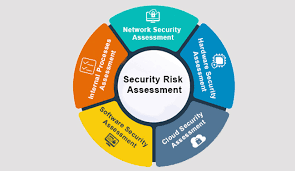In the fast-growing world of e-commerce, cybersecurity is no longer optional — it’s a survival necessity. With increasing threats like phishing, malware, ransomware, and data breaches, online retailers must proactively protect their digital assets and customer trust. One of the most critical steps toward that protection is conducting a cyber risk assessment.
In this guide, we’ll explain what a cyber risk assessment is, why e-commerce businesses need it, what the process involves, and how to choose the right cyber risk assessment service — along with recommendations and outbound links to trusted providers.
What Is a Cyber Risk Assessment?
A cyber risk assessment is a process that helps an organization identify, analyze, and evaluate potential cyber threats and vulnerabilities in its IT infrastructure, operations, and policies. For e-commerce, this includes assessing risks related to:
-
Customer data (PII and payment info)
-
Online transactions
-
Web applications
-
Third-party integrations
-
Cloud storage and APIs
A professional cyber risk assessment service not only identifies weaknesses but also recommends actionable solutions to mitigate them.

Why E-Commerce Businesses Need Cyber Risk Assessments
1. High-Value Target for Hackers
E-commerce platforms hold sensitive data: customer profiles, credit card details, addresses, and purchase histories. Hackers exploit this for identity theft, fraud, and resale on the dark web.
2. Compliance Requirements
Many e-commerce businesses must comply with:
-
PCI DSS (Payment Card Industry Data Security Standard)
-
GDPR (General Data Protection Regulation) for EU customers
-
CCPA (California Consumer Privacy Act)
-
SOC 2 for service providers
Failure to comply can lead to fines and customer lawsuits.
3. Third-Party Risks
Integrations with shipping, payment gateways, CRMs, or plugins create new attack surfaces. A thorough assessment can uncover these supply chain vulnerabilities.
4. Brand Reputation
A single breach can destroy years of brand building. Cyber risk assessments help avoid reputation damage and customer churn.
⚙️ What Does a Cyber Risk Assessment Include?
Here are the major components involved in a typical e-commerce cyber risk assessment:
✅ 1. Asset Identification
-
Website, CMS (like Shopify, Magento, WooCommerce)
-
Databases and cloud storage
-
Payment gateways
-
APIs and third-party plugins
-
Customer data and internal systems
✅ 2. Threat Identification
-
Malware, ransomware
-
SQL injections
-
DDoS attacks
-
Credential stuffing
-
Insider threats
✅ 3. Vulnerability Scanning
-
Automated scans for misconfigurations, outdated software, weak passwords, exposed ports
✅ 4. Security Controls Review
-
Review of firewalls, access control, encryption
-
Testing two-factor authentication (2FA), data backup policies
✅ 5. Risk Analysis and Scoring
-
Assign risk levels (low, medium, high) based on:
-
Likelihood of attack
-
Impact on business
-
Existing controls
-
✅ 6. Recommendations & Remediation
-
Actionable steps to fix or reduce each identified risk
-
Prioritized roadmap with short- and long-term goals
✅ 7. Reporting and Compliance Mapping
-
Clear, executive-friendly report
-
Mapping to PCI-DSS, SOC 2, or GDPR compliance frameworks
Choosing the Right Cyber Risk Assessment Service
When selecting a provider, consider the following:
1. Industry Experience
Choose a firm experienced with e-commerce platforms like Shopify, WooCommerce, BigCommerce, or Magento.
2. Certifications & Frameworks
Ensure the service uses industry standards like:
-
NIST Cybersecurity Framework
-
ISO 27001
-
OWASP Top 10
3. Customization & Scalability
A good provider tailors the assessment to your platform, customer size, and tech stack — not a one-size-fits-all solution.
4. Reporting & Actionability
Look for detailed yet understandable reports with clear recommendations — not just technical jargon.
5. Ongoing Monitoring
Some providers offer continuous vulnerability scanning, penetration testing, or vCISO support.
Top Cyber Risk Assessment Services for E-Commerce (2025)
Here are some of the best-reviewed and trusted providers in this space:
1. UpGuard
A popular platform offering risk assessments and vendor risk management tailored for online businesses.
Features:
-
Automated risk scoring
-
Third-party risk assessments
-
Continuous monitoring
-
Email breach alerts
2. Cobalt.io
Provides pentesting-as-a-service, ideal for e-commerce platforms wanting deeper, manual assessments.
Features:
-
OWASP Top 10 testing
-
Secure DevOps support
-
Real-time dashboard for remediation
3. SecurityScorecard
Offers external-facing cyber risk scores and attack surface visibility for e-commerce and vendors.
Features:
-
Risk ratings across 10 categories
-
Continuous third-party monitoring
-
Vendor risk management
4. Comodo Cybersecurity
Affordable and scalable for small-to-midsize online retailers.
Features:
-
Threat detection
-
Compliance assistance
-
24/7 support and remediation guidance
5. Palo Alto Networks (Prisma Cloud)
More suited for larger e-commerce companies operating in multi-cloud or hybrid environments.
Features:
-
Cloud infrastructure security
-
Code-to-cloud risk assessment
-
Compliance enforcement
Common E-Commerce Vulnerabilities Found in Risk Assessments
| Vulnerability | Potential Impact |
|---|---|
| Unpatched CMS or plugins | Website takeover, data exfiltration |
| Weak admin passwords | Credential stuffing, unauthorized access |
| Lack of HTTPS | Data interception, customer distrust |
| Misconfigured APIs | Data leakage, authentication bypass |
| No MFA | Easy account hijacking |
| Third-party plugin flaws | Supply chain breaches |
Fixing these before they’re exploited can save millions in recovery costs.
Example Cyber Risk Assessment Report Snapshot
| Category | Risk Level | Recommendation |
|---|---|---|
| Website Encryption | Medium | Implement TLS 1.3 and HSTS |
| WordPress Plugin X | High | Remove/Update plugin due to known vulnerabilities |
| Admin Panel Access | High | Restrict by IP and enforce 2FA |
| S3 Bucket Settings | Medium | Enable encryption and access logs |

💬 Pro Tips for E-Commerce Cyber Hygiene
-
Use PCI-compliant payment gateways like Stripe or PayPal
-
Enforce password complexity rules for admins and users
-
Schedule quarterly vulnerability scans
-
Limit and monitor third-party integrations
-
Implement a Content Security Policy (CSP) for browser-based protection
📌 Final Thoughts
Cyber risk assessments aren’t just for large enterprises. For e-commerce businesses of any size, they are essential for:
-
Identifying blind spots
-
Preventing breaches
-
Building trust with customers
-
Achieving compliance
By working with a trusted cyber risk assessment service, your e-commerce platform can stay ahead of cyber threats and continue to grow safely.
🛒 Ready to Get Started?
Explore professional cyber risk assessment services tailored for e-commerce:
🔗 UpGuard Cyber Risk Assessment






